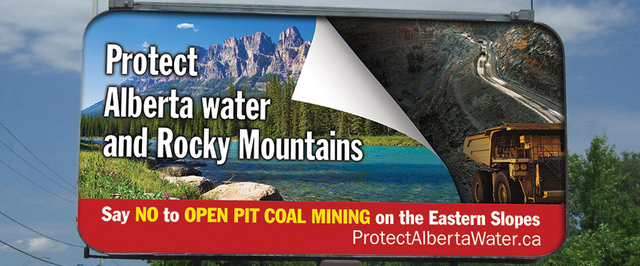THERE ARE SEVERE CONSEQUENCES THAT WILL BE FELT BY ALL ALBERTANS IF SURFACE MINING IS PERMITTED TO PROCEED IN THE HEADWATERS AND SENSITIVE AREAS OF OUR EASTERN SLOPES
These consequences include:
- The most significant and far-reaching consequence is the threat to our water. Surface mining will damage our watersheds in the Eastern Slopes, become a heavy user of this precious resource, and poison the water with selenium for generations.
- Recreational and tourism related businesses will be destroyed. Hiking, camping, hunting, cross country skiing, fishing and many other outdoor activities are at odds with open pit mining and will disappear in these areas. Parks in the region stretching north through the Rockies are threatened as more coal leases are sold.
- Farms that are dependent on water irrigation systems in arid southern Alberta will be threatened. Crop production is a diverse industry in southern Alberta and operations vary in size from small market operations to large scale commercial farms. All of these operations depend on a source of good water for survival.
- Our iconic Rocky Mountains will have their tops (or sides)removed by explosives in the process of locating, exposing and extracting the vein of coal that will be sold to China. Regardless of promises made by the coal mining companies, our mountains cannot be replaced.
- The eastern slopes of southern Alberta is ranching country. Cattle graze in the areas that the mining companies plan to exploit. Not only will the lack of (or selenium poisoned) water be devastating to this industry, but the mines will destroy the actual grazing lands. The process of open pit mining involves removing the top soil and turf. This turf is currently rich with natural rough fescue. It is a hardy, particularly nutritious plant that sustains cattle and wildlife. However, once this ancient grass is disturbed, it is very difficult (if not impossible) to remediate.
- After the turf with the rough fescue is removed, the top of the mountain is actually removed with explosives. The rubble tumbles down the valley and it is from this rock rubble that the selenium leaches into ground water. Wildlife will no longer be able to survive in the vicinity. Not only is the water they depend on threatened, but their feed as well. The rough fescue that they rely on is important to sustain elk and bighorn sheep through the winter. Roads and heavy machinery will infiltrate the area, threatening wildlife (including grizzly bear and cougar) and push them into areas that are more populated and not suited for their survival.
- The white bark pine and limber pine are examples of species at risk that are native to the mountains and foothills. They grow at treeline on steep rocky cliffs. When surface mining removes the turf and vegetation, it is not selective. It removes species at risk as well.
- Health issues will develop from the coal dust. Many Albertans (as well as wildlife and cattle) will suffer the consequences of coal dust taking the place of fresh mountain air.
- The Eastern Slopes support First Nations traditions including hunting, fishing, trapping, gathering, travelling, and cultural practices. Exploration and coal developments will infringe on First Nations Treaty Rights.
- Alberta will be investing in an industry that will negatively impact our reputation for working to reduce impacts on climate change.
- Our downstream neighbours in Saskatchewan and Manitoba will be negatively affected. Lawsuits from downstream users in the United States are a current reality as a result of the BC mines. Alberta will logically be at risk from lawsuits as well.
- Coal prices fluctuate and coal mining companies are in the business to make money. When the price of coal drops, the companies will move out. Alberta will be left with unspeakable environmental damage.
